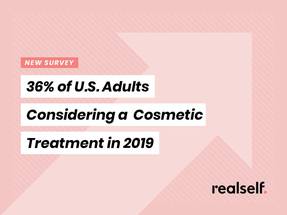RealSelf Survey: 36 Percent of US Adults Are Considering Cosmetic Treatments

More than four in five U.S. adults want to improve their personal well-being or appearance in 2019, and 36 percent are considering cosmetic treatments, according to new RealSelf survey.
Fully 82 percent of U.S. adults plan to make changes related to their personal well-being and/or appearance in 2019, most notably exercise more (58 percent), eat healthier foods (55 percent), invest more in mental health (33 percent), and make greater efforts to lose weight (32 percent).
Millennials aged 18-34 are more likely than those 35 and older to be planning personal well-being or appearance changes of any kind (88 percent vs. 80 percent), the survey showed.
Thirty six percent of U.S. adults are considering one or more cosmetic treatments in the next 12 months. This is more than 60 percent higher than those who report they have had a cosmetic procedure in the past (22 percent). Consideration is highest among women, millennials ages 18 to 34, and parents with children under the age of 18. Women (42 percent) are significantly more likely than men (30 percent) to be considering cosmetic treatments in the next 12 months. Millennials are nearly twice as likely as adults 35 and older to be considering a surgical or nonsurgical treatment in the next 12 months (57 percent vs. 28 percent), and half (50 percent) of parents with children under 18 are currently considering cosmetic treatments, compared to only 28 percent of U.S. adults without children under 18.
"People want to make positive changes in their lives and take steps to look as good as they feel," says New York City plastic surgeon Dr. Lara Devgan, RealSelf Chief Medical, in a news release. "This survey reinforces the trends we're observing on RealSelf and what I'm seeing in my own practice—adults in their 20s and 30s are prioritizing self-care and many view cosmetic treatments as one part of their holistic health and beauty routine. With new technologies and minimally invasive treatment options entering the market every year, procedures are becoming more accessible and a growing number of Americans are exploring their elective treatment options."
One-third of U.S. adults (33 percent) are considering nonsurgical treatments in the next 12 months while 22 percent are considering surgical treatments. Cosmetic dentistry (32 percent) and laser hair removal (30 percent) are the top choices among those interested in nonsurgical options, while tummy tuck (30 percent) and chin or neck lift (25 percent) top the list for surgical procedures.
Top 5 Nonsurgical Treatments Being Considered in Next 12 Months 2 | Top 5 Surgical Treatments Being Considered in Next 12 Months |
1. Cosmetic Dentistry (32%) (e.g., Invisalign, Whitening, Veneers) 2. Laser Hair Removal (30%) 3. Facial Skin Treatments (25%) (e.g., Dermaplaning, Microneedling) 4. Facial / Lip Fillers (24%) 5. Botox / Toxins (21%) | 1. Tummy Tuck (30%) 2. Chin or Neck Lift (25%) 3. Arm or Leg Lift (19%), Eyelid Surgery (19%) 4. Liposuction (17%), Breast Augmentation (17%) 5. Facelift (16%) |
Among those who have previously had cosmetic treatments or are considering them in the next 12 months, the top motivation was/is to improve self-esteem and confidence (40 percent) followed closely by looking as good as one feels (36 percent).
Main Motivations for Having/Considering Cosmetic Treatments: | Overall % |
To improve my self-esteem/confidence | 40% |
To look as good as I feel | 36% |
To look younger | 26% |
Help with weight loss/fat removal | 22% |
Combat aging | 22% |
Convenience and to save time/effort | 15% |
Get my body back after having children | 12% |
This survey was conducted online within the United States by The Harris Poll on behalf of RealSelf from December 13-17, 2018 among 2,021 U.S. adults ages 18 and older, among whom 777 have had cosmetic treatments and/or are considering cosmetic treatments in the next 12 months. This online survey is not based on a probability sample and therefore no estimate of theoretical sampling error can be calculated.

Facebook Comments